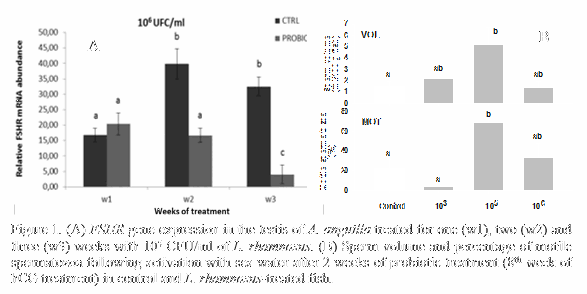EFFECT OF THE PROBIOTIC Lactobacillus rhamnosus ON SPERM QUALITY AND ON THE EXPRESSION OF GENES INVOLVED IN EUROPEAN EEL (Anguilla anguilla) SPERMATOGENESIS
Introduction
European eels do not mature spontaneously in captivity and sexual development of male and female specimens must be induced with long-term hormonal treatments (Asturiano et al., 2005; Pérez et al., 2000). In order to obtain good results, it is also recommended to control the maturation timing of both sexes. Of all the solutions dealing with the reproduction of this species, a good starting point could be the development of protocols that focus on obtaining high-quality sperm.
The majority of beneficial bacteria has been used as biological control agents in aquaculture. In a recent work, Gioacchini and collaborators (2012) investigated the effect of dietary probiotics on zebrafish reproduction's endocrine control as well as on the auto/paracrine factors involved in the regulation of oocytes maturation.
In the present study, for the first time and with the aim of improving the sperm quality of this species, we examined the effects of L. rhamnosus administration on European eel during the early stages of spermiation.
Materials and Methods
A total of 40 adult male eels (mean body weight 115±8g) were equally and randomly distributed in five 90-liter aquaria (8 males per treatment). Two aquaria represented the Control group (C) and the remaining three were used for Probiotic treatments (P) at three different concentrations (103, 105, 106 CFU/ml water). Animals were matured with nine hCGrec (recombinant hCG) weekly injections while daily probiotic administration started from the sixth week onwards.
Testis samples were collected after one, two and three weeks of probiotic dosages (that corresponded to the seventh, eighth and ninth week of the hCGrec treatment, respectively) and conserved in RNAlater®. Sperm samples were collected after 24h of hormone administration, and the motility analyses were performed in duplicates at 5s post-activation with a CASA software (ISAS v1; Proiser R&D, S.L., Paterna, Spain).
Plasma concentrations of 17β-estradiol (E2), 11-ketotestosterone (11-KT) and 17,20βP (DHP) were measured by means of radioimmunoassay.
Expression patterns of the following genes, which are all implicated in the maturation process, were studied by means q-PCR: Activin, Androgen Receptor α and β, Progesterone receptor 1, Bone Morphogenetic Protein 15 and Follicle Stimulating Hormone receptor, abbreviated as activin, arα, arβ, pr1, bmp15 and fshr, respectively. Actin was used as the internal reference gene.
Results
L. rhamnosus at 105 CFU/ml induced significant differences compared to controls, increasing the levels of activin, arα, arβ, pr1 and fshr (Fig.1A) gene expression after 1 and 2 weeks of probiotic treatment. Conversely, after 3 weeks of treatment, activin and pr1 were lowered. No significant changes were observed during the first week treatment on the bmp15 gene expression, while the expression significantly increased at two and three weeks of treatment.
The lowest (103 CFU/ml) and the highest (106 CFU/ml) doses inhibited the transcription of all genes herein reported after 1, 2 and 3 weeks of probiotic treatment, except for arα and arβ after 1 week of treatment. This suggests a possible negative role of these two doses on eel's reproductive physiology.
Regarding the sperm parameters, significant higher volumes of sperm, and higher percentages of motile and progressive motile (straight line swimmers) spermatozoa were found in fish exposed to 105 CFU/ml after 2 weeks of probiotic treatment (Fig. 1B). No significant differences on sperm parameters were found in other samplings.
At the same time, DHP levels in blood plasma were higher in fish treated with intermediate and high doses. No significant differences were detected in the levels of E2 and the levels of 11KT were higher in lowest dose after one week of probiotic treatment.
Discussion and conclusion
Due to the importance of the genes here analyzed within the reproductive process, our results suggest the dose of 105 CFU/ml and two weeks as the best treatment to modulate eel spermatogenesis process. This hypothesis is supported by the results on sperm volume motility and DHP levels. Additional studies are necessary to better elucidate the role of L. rhamnosus on European eel spermatogenesis.
Acknowledgements
Funded by EU (PRO-EEL, grant agreement n°245257). Grant to attend the meeting from COST Office (Food and Agriculture COST Action FA1205: AQUAGAMETE). Valenciana de Acuicultura, S.A. (Puzol, Spain) supplied the eels used in this study.
References
Asturiano, J.F., Pérez, L., Garzón, D.L., Peñaranda, D.S., Marco-Jiménez, F., S. Martínez Llorens, Tomás, A., Jover, M., 2005. Effect of different methods for the induction of spermiation on semen quality in European eel. Aquaculture Research 36:1480-1487.
Pérez, L., Asturiano, J.F., Tomás, A., Zegrari, S., Barrera, R., Espinós, J.F., Navarro, J.C., Jover, M., 2000. Induction of spermiation in the male European eel: assessment of sperm quality throughout treatment. Journal of Fish Biology 57: 1488-1504.
Gioacchini, G., Giorgini, E., Merrifield, D.L., Hardiman, G., Borini, A., Vaccari, L., Carnevali, O., 2012. Probiotics can induce follicle maturational competence: the Danio rerio case. Biology of Reproduction 86: 1-11.
